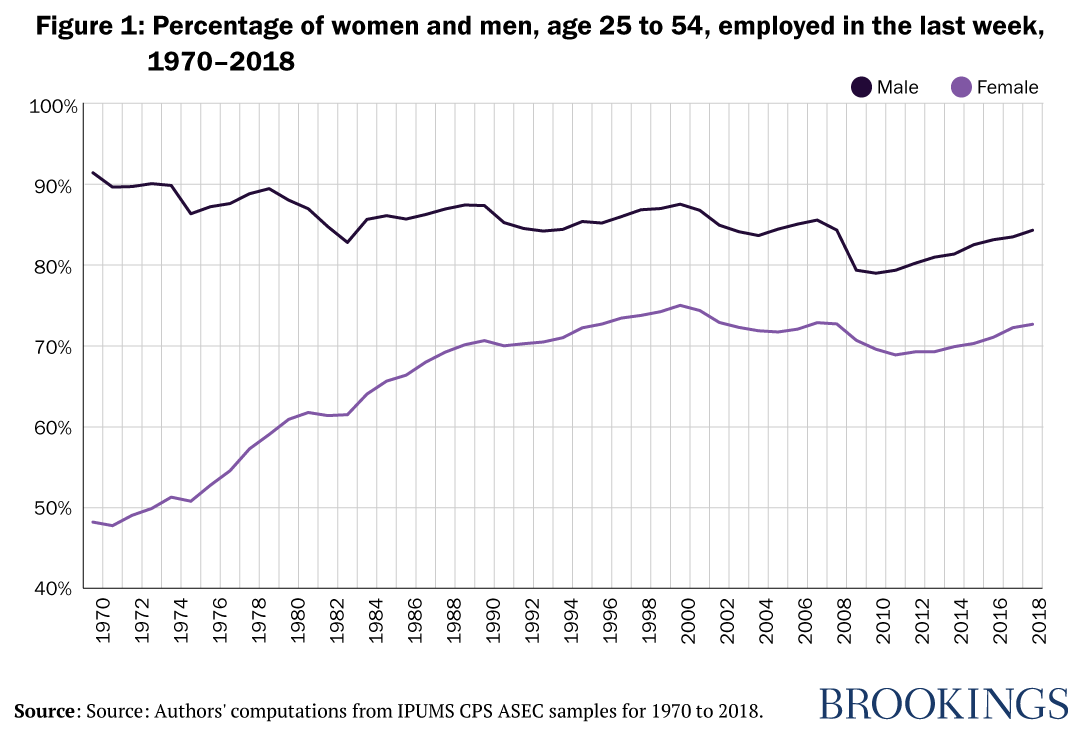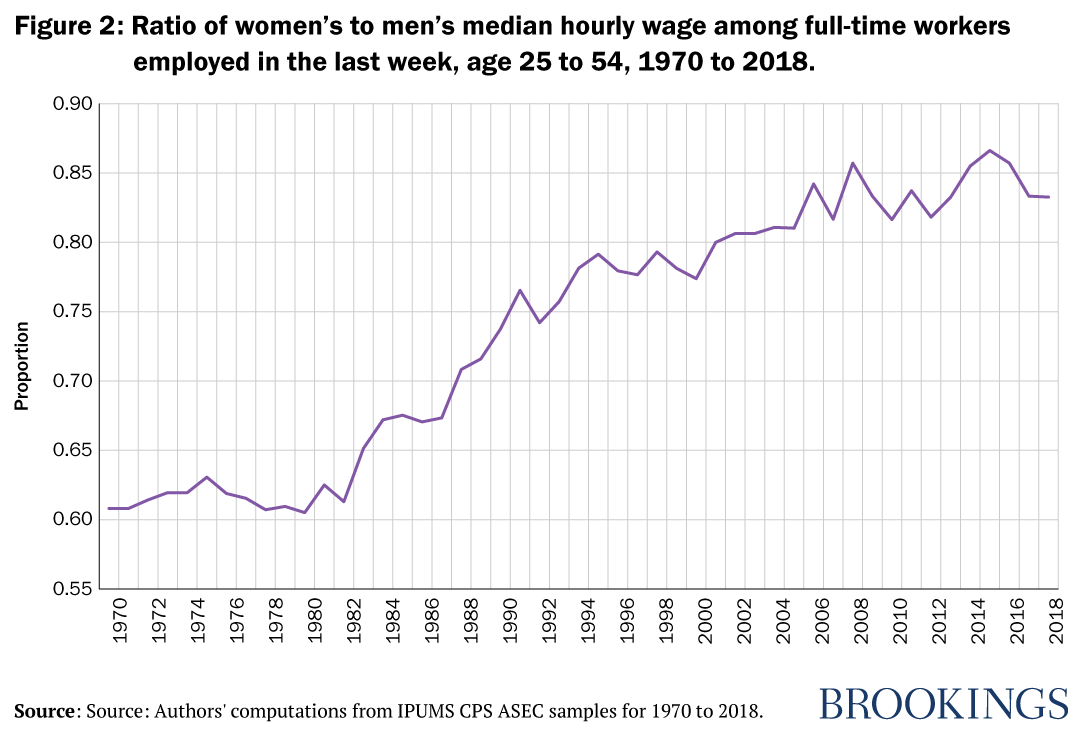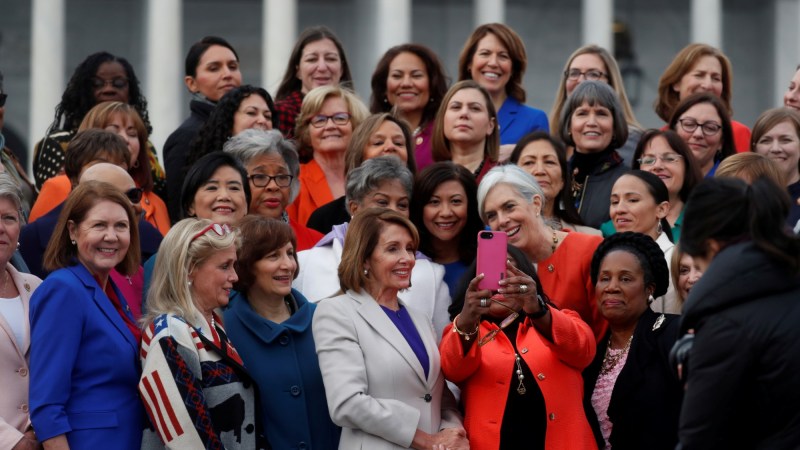
The gender revolution is stalling—What would reinvigorate it?
Progress toward gender equality over the last 50 years has been so dramatic that the changes are sometimes referred to as the “gender revolution.” However, since about the turn of the century, progress has slowed and, on some indicators, completely stalled. Here we describe trends in women’s employment, whether men or women are more likely to get college and doctoral degrees, how segregated fields of study and occupations are, and the gender pay gap. We then consider what needs to change if we want to reinvigorate progress toward gender equality.
The rise in women’s employment was dramatic – then it stopped
The most fundamental change in gender inequality has been the dramatic rise in women’s employment. As Figure 1 below shows, the percent of women employed for pay rose steadily from 1970 to 2000, moving from 48 percent to 75 percent of women employed. However, since 2000, despite some small ups and downs, the percent employed has shown no net increase. Indeed, the 2018 level—73 percent of women employed—was slightly lower than the 2000 figure of 75 percent. Women’s employment has thus been plateaued for about 20 years. Moreover, separate analyses (not shown here) reveal that the more education a woman has, the more likely she is to be employed, but that what women of all educational levels have in common is that their percent employed has plateaued.

Women have surpassed men in acquiring college degrees, but differences in specific fields of study persist
In contrast to the stall in women’s employment, getting higher education is the one area in which women have not only caught up to men, but moved ahead of them. Women surpassed men in getting college (baccalaureate) degrees in the mid-1980s. More recently, in this century, women edged ahead of men in getting doctoral degrees (PhDs, MDs, JDs in law, and other doctorates). Since there are approximately the same number of men and women in the population at the young ages where degrees are generally earned, if women were as likely to get degrees as men we would expect the ratio of the number of men to women getting such degrees to be 1. Thus, we can measure progress toward—or beyond—gender equality by change in this ratio. (A ratio below 1 means men get more degrees, while a number above 1 means women get more.) Between 1970 and 2018, for baccalaureate degrees this ratio moved from women getting .76 as many degrees as men to getting 1.34 as many. For doctoral degrees, the ratio of women to men getting degrees went from .13 to 1.18 across the same period. Women are now more educated than men in the U.S., and in many other countries as well.
Despite the fact that women now get more baccalaureate and doctoral degrees than men, there are still many lucrative fields, for example engineering and computer science, that remain male bastions because fewer women than men major in those subjects. Fields of study are still quite segregated by gender. A useful measure of the level of segregation in fields of study for any given year is the index of dissimilarity, which, roughly speaking, shows what percent of men or women would need to change majors to achieve complete integration, meaning that each field would have the same percent women as women constitute of graduates of all fields combined. Using this index, and dividing all fields into 17 categories, our analysis shows that for baccalaureate degrees, 47 percent of women or men would have had to change fields to integrate them in 1970, and this declined to 28 percent by 1998.
The partial integration occurred as fewer women majored in some traditionally female fields, such as education, English, and sociology, and more women graduated in traditionally male fields such as business, accounting, marketing, and biology. However, there has been no further desegregation of fields of study for baccalaureate degrees since 1998; in fact, the segregation index has increased a few points since then. For doctoral degrees, the index moved from 35 percent to a low of 18 percent in 1987, in large part from the large increase of women getting MDs and JDs, but there has been no further integration since. Thus, desegregation for both baccalaureate and doctoral degrees has been substantial, but has been stalled for approximately 20 years, since before the turn of the 21st century.
It’s not just school. Gender segregation exists in employment too.
Partly because of the segregation of college majors, and for a host of other reasons, men and women are distributed very differently across occupations. But, starting in the 1970s, many women, especially those with college degrees, entered traditionally male managerial and professional jobs such as middle management, accounting, medicine, law, academia, pharmacy, and the clergy. Women without college degrees made fewer inroads into the blue-collar jobs that men without degrees have traditionally worked in such as carpentry, plumbing, and auto and steel manufacturing. We used the same segregation index described above to quantify how much occupations have desegregated since 1970. We found that the percent of men or women who would have to move occupations to produce integration (defined by women constituting the same percent of each job as they are of the employed workforce as a whole) went from 60 percent in 1970 to 42 percent in 2018. But, whereas segregation dropped by 12 percentage points in the 20-year period after 1970, the drop in the much longer 28-year period from 1990 to 2018 was a much smaller 5 points. Thus, the progress women have made in desegregating occupations has not stalled, but it has slowed severely, and it is a long way from the 0 that would imply complete integration of fields.
What about the gender pay gap?
Limiting our analysis to women and men who work full-time (defined as at least 35 hours/week), Figure 2 shows what percent a woman earning the women’s median (i.e., 50th percentile) made of the amount earned by men at their median. In the 1970s women made about 60 percent what men did. After 1980 this rose dramatically to 74 percent by 1990. The percent has continued to rise since then, so that, by 2018, women earned 83 percent what men did at the median. Progress since 1990 has been at a much slower pace than in the 80s, the decade in which women gained most on men; the rise (in percentage points) was more in the single 10-year period of the 1980s than it was in the 28 years from 1990 to 2018. Clearly, progress toward equal pay has slowed down, but it has not stopped.

This slowdown of progress in the gender pay gap is not only shown at the median of women’s and men’s earnings, it is seen toward the top and bottom of the distributions too. In other analyses not shown here, we calculated what percent women at the 10th percentile of their distribution make of the earnings of men at their 10th percentile, and we did the same for the 90th percentile. Whether toward the top (the 90th) or the bottom (the 10th), we found that women’s earnings have gotten closer to men’s, but that the rate of change has slowed substantially since 1990.
Reinvigorating the gender revolution
What would be necessary for further progress in all the areas where the movement toward equality has slowed or stalled—employment, desegregation of fields of study and jobs, and the gender pay gap? A new push toward gender equality requires changes in both institutional policies (by employers or government) and culture (values, beliefs, and preferences). The two can reinforce each other, with each having effects on both the supply and demand side of labor markets.
Several kinds of institutional changes by government or employers would encourage gender equality. Consider first what would increase women’s employment, which has stalled at under 75 percent. If child care were publicly financed for children whose parents wanted to use it, women’s employment rates would undoubtedly go up. Publicly supported child care would especially increase the employment of women whose potential earnings are low enough that, after they pay for child care from their earnings, too little is left to make the jobs they can get worth taking.
The segregation of jobs and the sex gap in pay would be decreased by strong state enforcement of anti-discrimination policies and mandated or voluntary adoption by employers of tools to reduce the gender bias, subtle or explicit, that sometimes inflicts hiring, promotion, and the setting of pay differences within jobs. Other policies that could reduce gender segregation of jobs and the pay gap include: (state mandated or voluntary) employer policies that provide parental leave; flexible movement between full- and part-time work while staying on career ladders; and choice about which hours of the day to work. These policies could help couples wanting a gender-egalitarian division of labor to coordinate paid work and care work at home.
A substantial part of the gender gap in pay comes not from lack of equal pay for men and women in the same job but from women’s concentration in lower paying occupations. Thus, the pay gap could be reduced by reducing job segregation, as discussed above. Another route to reducing the between-occupation part of the gender pay gap is to make policy changes that remove gender bias from decisions about pay differences between predominantly male and female occupations. Research shows that predominantly female jobs have systematically lower pay than predominantly male jobs that entail different tasks but require the same amount of education. Further statistical adjustments for other skill demands or working conditions typically can’t explain the differences.
It appears that employers have (perhaps unconsciously) taken the gender composition of jobs into account when setting wages. Under current U.S. laws, it is illegal to take sex into account when deciding whom to hire or whether to pay them more or less than others within their same job. But the issue called “comparable worth” or “pay equity” in the 1990s raised the question of whether pay differences between jobs sometimes result from employers’ biased perceptions that jobs filled mainly by women just can’t be that important. Proponents of this type of between-job pay equity never succeeded in attempts to get the courts to see these differentials as illegal discrimination, or in getting new legislation passed. Addressing this issue with new legislation is important for closing the gender gap in pay.
To date, the gender revolution has been profoundly asymmetric—more women entered “male” fields than vice versa, and women’s employment hours went up much more than men’s household work hours went up. But, without an increase in men’s household work and child care, it will be harder for women’s career success to approach men’s, and changes in informal norms would help this along.
To complement the institutional changes described above, those wanting to continue the gender revolution could usefully promote cultural change. Today many accept that girls and women should be able to make nontraditional choices—playing sports, studying math, or aspiring to leadership. We’ve made less progress in accepting changes in men’s roles. If it was more socially acceptable for a husband to work part-time or take time out of employment to care for his children, the gender gap in employment would fall. If the idea of a woman out-earning her husband were unremarkable and not stigmatizing to either the woman or the man, this would be one less impediment to women’s career success. To date, the gender revolution has been profoundly asymmetric—more women entered “male” fields than vice versa, and women’s employment hours went up much more than men’s household work hours went up. But, without an increase in men’s household work and child care, it will be harder for women’s career success to approach men’s, and changes in informal norms would help this along. If employers adopt policies to ease the coordination of work and family, but men seldom take advantage of them, the policies, while helping some families, may further reinforce the idea that care is women’s responsibility.
Cultural change is also needed be to reduce the strong level of sex segregation in fields of study and in occupations. While some of this segregation undoubtedly comes from employer discrimination, it is also buttressed by social forces from childhood through adulthood that shape differences between men and women in which jobs they are confident they can do, and which they find interesting, meaningful, and identity-enhancing. Deliberate attempts to change these cultural messages could change behavior on the supply side of labor markets by orienting men and women to different jobs, and on the demand-side by changing employers’ assumptions about who fits and will perform well in what job and who deserves higher pay.
The cultural and institutional changes of the last 50 years have brought us a gender revolution that has slowed and in some cases stalled. We have the choice to reinvigorate change toward gender equality by seeking deeper cultural and institutional change.
This post draws upon the research by Paula England, Andrew Levine, and Emma Mishel, “Progress Toward Gender Equality in the United States Has Slowed or Stalled,” Proceedings of the National Academy of Sciences, vol. 117, no. 13 (2020), pp. 6990-6997. https://www.pnas.org/content/117/13/6990
This piece is part of 19A: The Brookings Gender Equality Series. Learn more about the series and read published work »






